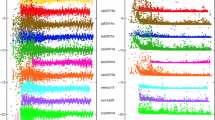Abstract
VLBI-based offsets of the Celestial Pole positions, as well as the variations of UT (series of Goddard Space Flight Center, 1984–2005) are processed applying the Earth’s rotation theory (ERA) 2005 constructed by the numerical integration of the differential equations of rotation of the deformable Earth. The equations were published earlier (Krasinsky 2006) as the first part of the work. The resulting weighted root mean square (WRMS) errors of the residuals \({{\rm d}\theta}\) , \({{\rm sin}\theta{\rm d}\phi}\) for the angles of nutation \({\theta}\) and precession \({\phi}\) are 0.136 and 0.129 mas, respectively. They are significantly less than the corresponding values 0.172 and 0.165 mas for the IAU 2000 model adopted as the international standard. In ERA 2005, the angles \({\theta}\) , \({\phi}\) are related to the inertial ecliptical frame J2000, the angle \({\phi}\) including the precessional secular motion. As the published observational data are theory-dependent being related to IAU 2000, a procedure to confront the numerical theory to the observed Celestial Pole offsets and UT variations is developed. Processing the VLBI data has shown that beside the well known 435-day FCN mode of the free core nutation, there exits a second mode, FICN, caused by the inner part of the fluid core, with the period of 420 day close to that of the FCN mode. Beatings between the two modes are responsible for the apparent damping and excitation of the free oscillations, and are implicitly modeled by ERA 2005. The nutational and precessional motions in ERA 2005 are proved to be mutually consistent but only in case the relativistic correction for the geodetic precession is applied. Otherwise, the overall WRMS error of the residuals would increase by 35%. Thus, the effect of the geodetic precession in the Earth rotation is confirmed experimentally. The other finding is the reliable estimation δc = 3.844 ± 0.028° of the phase lag δc of the tides in the fluid core. When processing the UT variations, a simple model of the elastic interaction between the mantle and fluid core at their common boundary made it possible to satisfactory describe the largest observed oscillations of UT with the period of 18.6 year, reducing the WRMS error of the UT residuals to the value 0.18 ms (after removing the secular, annual and semi-annual terms).
Similar content being viewed by others
References
Aleshkina E.Ju., Krasinsky G.A., Vasilyev M.V. (1997) Analysis of LLR data with the program system ERA. In: Wytrzyszczak I.M., Lieske J.H., Feldman R.A. (eds) Dynamics and Astrometry of Natural and Artificial Celestial Bodies. Kluwer, Dordrecht, pp. 227–232
Dickey J.O., Bender P.L., Faller J.E., Newhall X.X., Ricklefs R.L., Ries J.G., Shelus P.J., Veillet C., Whipple A.L., Wiant J.R., Williams J.G., Yoder C.F. (1994) Lunar laser ranging: a continuing legacy of the apollo program. Science 65, 482–490
Fukushima T. (1991) Geodesic nutation. Astron. Astrophys. 244, L11–L12
Krasinsky G.A., Saramonova E.Yu., Sveshnikov M.L., Sveshnikova E.S. (1985) Universal time, lunar tidal deceleration and relativistic effects from observations of transits, eclipses, and occultations XVIII–XX centuries. Astron. Astrophys. 145N1, 90–96
Krasinsky G.A. (2002a) Dynamical history of the Earth-Moon system. Celest. Mech. Dyn. Astron. 84, 27–55
Krasinsky G.A. (2002b) Diurnal pole tides and determination of static and dynamic Love numbers from analysis of VLBI observations 1998–2001. Communications IAA RAS N 150:4–32
Krasinsky, G.A.: Numerical theory of rotation of the deformable Earth with the two-layer fluid core. Part 1: Mathematical model. Celest. Mech. Dyn. Astron. 96 (2006)
Krasinsky G.A., Vasilyev M.V. (1997) ERA: knowledge base for ephemeris and dynamical astronomy. In: Wytrzyszczak I.M., Lieske J.H., Feldman R.A. (eds) Dynamics and Astrometry of Natural and Artificial Celestial Bodies. Kluwer, Dordrecht, pp. 239–244
Malkin, Z.: Comparison of VLBI nutation series with the IAU 2000 model. In: Finkelstein, A., N. (eds.), Journées 2003, Systèmes de référence spatio-temporels. Astrometry, Geodynamics and Solar System Dynamics: from milliarcseconds to microarcseconds. IAA RAS, pp. 24–32 (2004)
Mathews P.M., Herring T.A., Buffet B.A. (2002) Modeling of nutation and precession: New nutation series for non-rigid Earth and insights into the Earth’s interior. J. Geophys. Res. 107(B4):1007, 10.1029/2001JB00390, 3-1-3-26.
McCarthy, D.D., Petit. G.: IERS Conventions (2003). IERS Technical Note No. 32. Verlag d. Bund. f. Kartographie u. Geodäsie, Frankfurt am Main (2004)
Shirai, T., Fukushima, T.: Construction of a new forced nutation theory of the non-rigid Earth. A.J. 121, N 1746 3270–3283 (2001)
Yoder C.F., Williams J.G., Parke M.E. (1981) Tidal variations of earth rotation. J. Geophys. Res. 86, 881–891
Author information
Authors and Affiliations
Corresponding author
Rights and permissions
About this article
Cite this article
Krasinsky, G.A., Vasilyev, M.V. Numerical theory of rotation of the deformable Earth with the two-layer fluid core. Part 2: Fitting to VLBI data. Celestial Mech Dyn Astr 96, 219–237 (2006). https://doi.org/10.1007/s10569-006-9033-x
Received:
Accepted:
Published:
Issue Date:
DOI: https://doi.org/10.1007/s10569-006-9033-x




